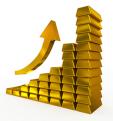This is the one scenario that will push institutional investors into gold
NEW YORK (July 30) Western investment demand is slowly starting to reemerge in the gold market as the Federal Reserve prepares to ease interest rates as early as September; however, according to one portfolio manager, one thing needs to happen before gold really takes off.
In a recent interview with Kitco News, Ryan McIntyre, Managing Partner at Sprott Inc., said that the gold market is on the cusp of a meaningful rally as demand for gold-backed exchange-traded funds starts to pick up.
McIntyre’s comments come as gold prices face stubborn resistance at $2,400 an ounce, only weeks after hitting an all-time high above $2,480 an ounce.
McIntyre said that while the Fed’s impending interest rate cut makes gold attractive by lowering the precious metal’s opportunity costs, there is still no real impetus for investors to jump into the market just yet.
“The environment for gold is improving, but I don’t think institutions have a strong buy signal. That won’t happen until there is more risk aversion in the marketplace,” he said.
He added that even with the Fed’s rate cut, real rates are still high enough that major funds can make money buying short-term money market funds. He noted this has been a winning trade as the Federal Reserve has maintained its aggressive monetary policy stance longer than expected.
“It's going to take somewhat of a dramatic shift to get people to think a little bit differently about how to build their portfolios,” he said. "Gold is unique in that way because there is no yield on it; there are no earnings derived from it, so it's hard for people to understand it. I think gold is probably one of the few avenues that people haven't really explored.”
However, McIntyre said that he expects investment sentiment to shift dramatically as a slowing economy starts to weigh on equity markets.
“We've got extreme valuations in the United States equity markets and in many other asset classes as well. For me, all roads – if people are looking for diversification – lead to gold,” he said.
Although the economy remains fairly resilient, expanding 2.8% in the second quarter, McIntyre said that he sees many red flags flashing warning signals. He added that the biggest threat remains the growing deficit.
"A 7 percent deficit in a booming economy should be freaking people out," he said, pointing to the potential for spiraling debt and its implications for the U.S. dollar's status as the world's reserve currency. “As the economy slows down, the deficit will be much, much higher.”
The comments come as U.S. debt hits a new record of $35 trillion.
“The price of gold is not reflected in the huge deficits we see worldwide,” he said.
While the Federal Reserve’s monetary policy will create short-term volatility in the gold market, McIntyre said he expects the growing deficit to have a much bigger long-term impact on the precious metal. He pointed out that it's only a matter of time before the U.S. dollar faces significant debasement.
He added that the only factor that continues to support the U.S. dollar as the world’s reserve currency is that there are no other alternatives. No other nation can match the size and liquidity of the U.S. bond market or the U.S. dollar.
“I expect that gold will remain the biggest competition against the U.S. dollar as nations continue to diversify their holdings,” he said.
KitcoNews









